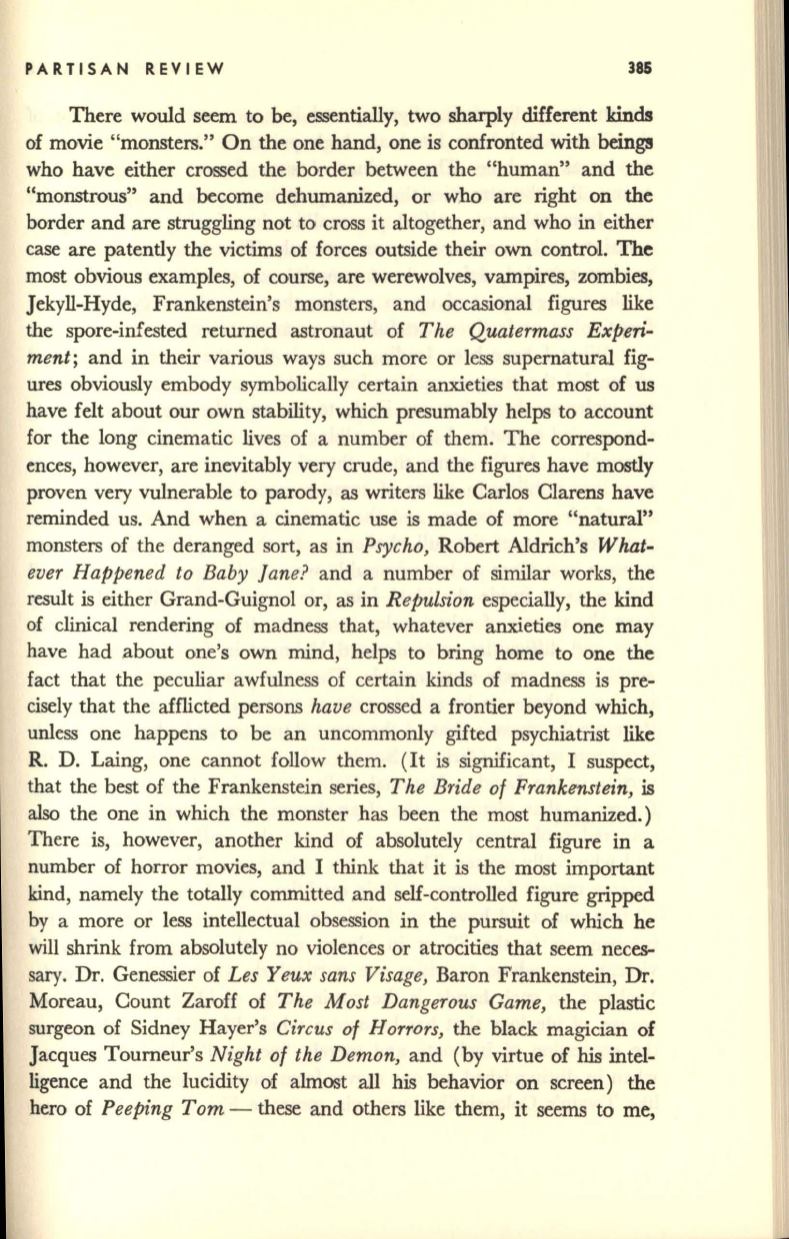
PARTISAN REVIEW
385
There would seem to be, essentially, two sharply different
kinds
of movie "monsters." On the one hand, one is confronted with
beings
who have either crossed the border between the "human" and the
"monstrous" and become dehumanized, or who are right on the
border and are struggling not to cross it altogether, and who in either
case are patently the victims of forces outside their own control. The
most obvious examples, of course, are werewolves, vampires, zombies,
Jekyll-Hyde, Frankenstein's monsters, and occasional figures like
the spore-infested returned astronaut of
The Quatermass Experi–
ment;
and in their various ways such more or less supernatural fig–
ures obviously embody symbolically certain anxieties that most of us
have felt about our own stability, which presumably helps to account
for the long cinematic lives of a number of them. The correspond–
ences, however, are inevitably very crude, and the figures have mostly
proven very vulnerable to parody, as writers like Carlos Clarens have
reminded us. And when a cinematic use
is
made of more "natural"
monsters of the deranged sort, as in
Psycho,
Robert Aldrich's
What–
ever Happened to Baby Jane?
and a number of similar works, the
result is either Grand-Guignol or, as in
Repulsion
especially, the kind
of clinical rendering of madness that, whatever anxieties one may
have had about one's own mind, helps to bring home to one the
fact that the peculiar awfulness of certain kinds of madness is pre–
cisely that the afflicted persons
have
crossed a frontier beyond which,
unless one happens to be an uncommonly gifted psychiatrist like
R. D. Laing, one cannot follow them.
(It
is significant, I suspect,
that the best of the Frankenstein series,
The Bride of Frankenstein,
is
also
the one in which the monster has been the most humanized.)
There is, however, another kind of absolutely central figure in a
number of horror movies, and I think that it is the most important
kind, namely the totally committed .and self-controlled figure gripped
by a more or less intellectual obsession in the pursuit of which he
will shrink from absolutely no violences or atrocities that seem neces–
sary.
Dr.
Genessier of
Les Yeux sans Visage,
Baron Frankenstein, Dr.
Moreau, Count Zaroff of
The Most Dangerous Game,
the plastic
surgeon of Sidney Hayer's
Circus of Horrors,
the black magician of
Jacques Tourneur's
Night of the Demon,
and (by virtue of
his
intel–
ligence and the lucidity of almost all his behavior on screen) the
hero of
Peeping Tom
- these and others like them, it seems to me,


